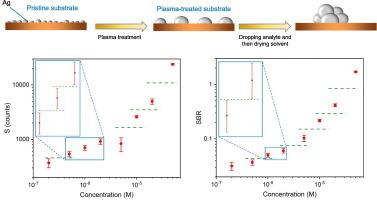Strongly enhancing discrimination of sample concentrations via analyte-induced hot spots: Leveraging combined signal and signal-to-background ratio in SERS measurement
IF 6.1
2区 材料科学
Q1 MATERIALS SCIENCE, COATINGS & FILMS
引用次数: 0
Abstract
Surface-enhanced Raman scattering (SERS) has been extensively used for the detection of various chemical and biological species. However, accurately quantifying analyte concentrations through SERS remains a challenge. Here, we report a new method that significantly enhancing the accuracy of quantification. We fabricated SERS substrates by thermally depositing Ag nanoparticles (AgNPs) on glass slides which were treated with plasma in an air‑oxygen mixture. The introduction of an analyte onto a plasma-treated substrate induced the aggregation of AgNPs, resulting in the formation of multiple hot spots referred to as analyte-induced hot spots, which exhibited strong Raman enhancing abilities. The degree of aggregation was conclusively shown to positively correlate with the analyte concentration, leading to heightened sensitivity towards concentration variations in both the signal (S) and signal-to-background ratio (SBR) in SERS measurements. With heightened sensitivity, both S and SBR exhibit the potential to effectively differentiate between analyte solutions with twofold concentration differences, evident from distinct error bar separations. This distinct separation applies to S and SBR across various concentrations, successfully broadening the detection range. The broadened range was successfully demonstrated in the detection of adenine solution, spanning from 2 × 10−6 and 5 × 10−4 M. To validate the practical applicability of our method in real sample analysis, we established the broadened detection range for thiram in apple juice to be from 2 × 10−7 to 5 × 10−5 M.

通过分析物引起的热点强烈增强对样品浓度的辨别:利用SERS测量中的组合信号和信本比
表面增强拉曼散射(SERS)已广泛用于各种化学和生物物质的检测。然而,通过SERS准确定量分析物浓度仍然是一个挑战。在这里,我们报告了一种新的方法,可以显著提高定量的准确性。我们通过在玻璃载玻片上热沉积银纳米粒子(AgNPs)来制备SERS衬底,玻璃载玻片在空气-氧气混合物中经过等离子体处理。在等离子体处理的衬底上引入分析物可诱导AgNPs聚集,从而形成多个热点,称为分析物诱导热点,表现出很强的拉曼增强能力。最终表明,聚集程度与分析物浓度呈正相关,导致SERS测量中信号(S)和信号与背景比(SBR)对浓度变化的敏感性提高。随着灵敏度的提高,S和SBR都显示出有效区分具有两倍浓度差异的分析物溶液的潜力,从不同的误差条分离中可以明显看出。这种独特的分离适用于不同浓度的S和SBR,成功地拓宽了检测范围。为了验证该方法在实际样品分析中的实用性,我们建立了苹果汁中硫胺的检测范围为2 × 10−7 ~ 5 × 10−5 M。
本文章由计算机程序翻译,如有差异,请以英文原文为准。
求助全文
约1分钟内获得全文
求助全文
来源期刊

Surface & Coatings Technology
工程技术-材料科学:膜
CiteScore
10.00
自引率
11.10%
发文量
921
审稿时长
19 days
期刊介绍:
Surface and Coatings Technology is an international archival journal publishing scientific papers on significant developments in surface and interface engineering to modify and improve the surface properties of materials for protection in demanding contact conditions or aggressive environments, or for enhanced functional performance. Contributions range from original scientific articles concerned with fundamental and applied aspects of research or direct applications of metallic, inorganic, organic and composite coatings, to invited reviews of current technology in specific areas. Papers submitted to this journal are expected to be in line with the following aspects in processes, and properties/performance:
A. Processes: Physical and chemical vapour deposition techniques, thermal and plasma spraying, surface modification by directed energy techniques such as ion, electron and laser beams, thermo-chemical treatment, wet chemical and electrochemical processes such as plating, sol-gel coating, anodization, plasma electrolytic oxidation, etc., but excluding painting.
B. Properties/performance: friction performance, wear resistance (e.g., abrasion, erosion, fretting, etc), corrosion and oxidation resistance, thermal protection, diffusion resistance, hydrophilicity/hydrophobicity, and properties relevant to smart materials behaviour and enhanced multifunctional performance for environmental, energy and medical applications, but excluding device aspects.
 求助内容:
求助内容: 应助结果提醒方式:
应助结果提醒方式:


